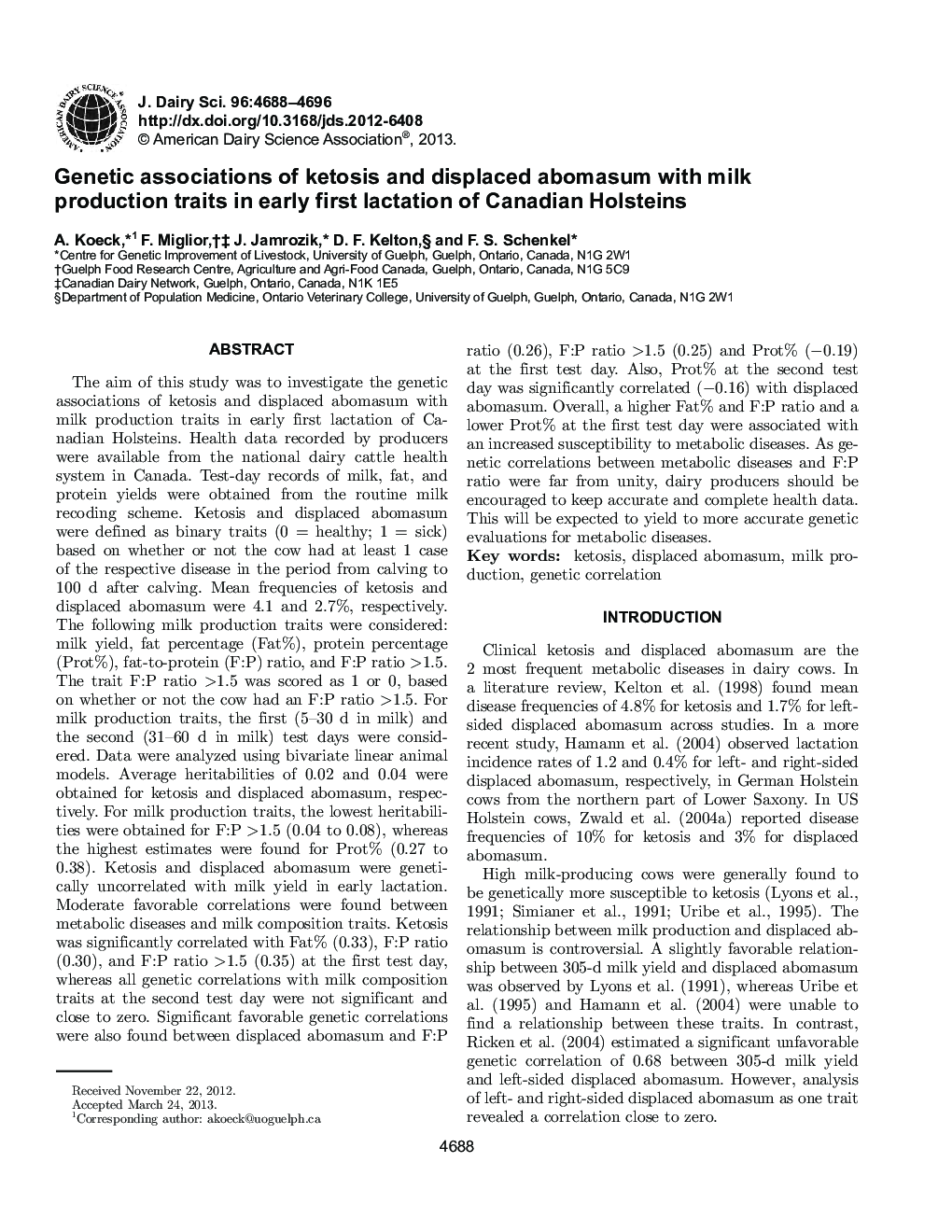| کد مقاله | کد نشریه | سال انتشار | مقاله انگلیسی | نسخه تمام متن |
|---|---|---|---|---|
| 10978060 | 1108054 | 2013 | 9 صفحه PDF | دانلود رایگان |
عنوان انگلیسی مقاله ISI
Genetic associations of ketosis and displaced abomasum with milk production traits in early first lactation of Canadian Holsteins
ترجمه فارسی عنوان
انجمن های ژنتیکی کتوز و ابوموسی جابجا شده با صفات تولید شیر در اوایل اولین شیردهی هولستین های کانادایی
دانلود مقاله + سفارش ترجمه
دانلود مقاله ISI انگلیسی
رایگان برای ایرانیان
کلمات کلیدی
کتوز، ابومازوم جابجا شده، تولید شیر، همبستگی ژنتیکی،
موضوعات مرتبط
علوم زیستی و بیوفناوری
علوم کشاورزی و بیولوژیک
علوم دامی و جانورشناسی
چکیده انگلیسی
The aim of this study was to investigate the genetic associations of ketosis and displaced abomasum with milk production traits in early first lactation of Canadian Holsteins. Health data recorded by producers were available from the national dairy cattle health system in Canada. Test-day records of milk, fat, and protein yields were obtained from the routine milk recoding scheme. Ketosis and displaced abomasum were defined as binary traits (0 = healthy; 1 = sick) based on whether or not the cow had at least 1 case of the respective disease in the period from calving to 100 d after calving. Mean frequencies of ketosis and displaced abomasum were 4.1 and 2.7%, respectively. The following milk production traits were considered: milk yield, fat percentage (Fat%), protein percentage (Prot%), fat-to-protein (F:P) ratio, and F:P ratio >1.5. The trait F:P ratio >1.5 was scored as 1 or 0, based on whether or not the cow had an F:P ratio >1.5. For milk production traits, the first (5-30 d in milk) and the second (31-60 d in milk) test days were considered. Data were analyzed using bivariate linear animal models. Average heritabilities of 0.02 and 0.04 were obtained for ketosis and displaced abomasum, respectively. For milk production traits, the lowest heritabilities were obtained for F:P >1.5 (0.04 to 0.08), whereas the highest estimates were found for Prot% (0.27 to 0.38). Ketosis and displaced abomasum were genetically uncorrelated with milk yield in early lactation. Moderate favorable correlations were found between metabolic diseases and milk composition traits. Ketosis was significantly correlated with Fat% (0.33), F:P ratio (0.30), and F:P ratio >1.5 (0.35) at the first test day, whereas all genetic correlations with milk composition traits at the second test day were not significant and close to zero. Significant favorable genetic correlations were also found between displaced abomasum and F:P ratio (0.26), F:P ratio >1.5 (0.25) and Prot% (â0.19) at the first test day. Also, Prot% at the second test day was significantly correlated (â0.16) with displaced abomasum. Overall, a higher Fat% and F:P ratio and a lower Prot% at the first test day were associated with an increased susceptibility to metabolic diseases. As genetic correlations between metabolic diseases and F:P ratio were far from unity, dairy producers should be encouraged to keep accurate and complete health data. This will be expected to yield to more accurate genetic evaluations for metabolic diseases.
ناشر
Database: Elsevier - ScienceDirect (ساینس دایرکت)
Journal: Journal of Dairy Science - Volume 96, Issue 7, July 2013, Pages 4688-4696
Journal: Journal of Dairy Science - Volume 96, Issue 7, July 2013, Pages 4688-4696
نویسندگان
A. Koeck, F. Miglior, J. Jamrozik, D.F. Kelton, F.S. Schenkel,
